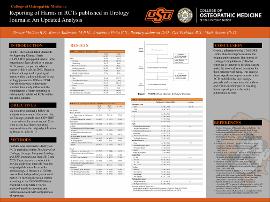| dc.contributor.author | MaGee, Trevor | |
| dc.contributor.author | Anderson, Reece | |
| dc.contributor.author | Peña, Andriana | |
| dc.contributor.author | Johnson, Bradley | |
| dc.contributor.author | Perkins, Del | |
| dc.contributor.author | Vassar, Matt | |
| dc.date.accessioned | 2023-11-02T20:44:17Z | |
| dc.date.available | 2023-11-02T20:44:17Z | |
| dc.date.issued | 2023-02-17 | |
| dc.identifier | ouhd_MaGee_reportingofharmsinRCTs_2023 | |
| dc.identifier.citation | MaGee, T., Anderson, R., Peña, A., Johnson, B., Perkins, D., and Vassar, M. (2023, February 17). Reporting of harms in RCTs published in urology journals: An updated analysis. Poster presented at Research Week, Oklahoma State University Center for Health Sciences, Tulsa, Ok. | |
| dc.identifier.uri | https://hdl.handle.net/11244/339892 | |
| dc.description.abstract | Introduction/Objectives: In 2004, the Consolidated Standards for Reporting Clinical Trials (CONSORT) group published a Harms extension to their checklist to ensure RCTs properly report on adverse events within trials. In 2010, Breau et. al found sub-optimal reporting of harms within studies published in top urology journals in 1996 and 2004. Our objective was to determine whether their study influenced the completeness of harm reporting in subsequently published RCTs within the same journals. | |
| dc.description.abstract | Methods: PubMed was searched to identify all RCTs published within The Journal of Urology, Urology, European Urology, and BJU International from 2012 and 2020. These years were selected to provide eight-year intervals from the original publication. In a similar methodology to Breau et. al (2010), two authors independently evaluated each RCT meeting inclusion criteria according to the CONSORT-Harms checklist. Using Stata 17.0, we analyzed trends in reporting and factors associated with completeness of reporting. | |
| dc.description.abstract | Results: Overall, adherence to the CONSORT-Harms checklist improved since the original publication in The Journal of Urology. Overall reporting improved significantly from 2012 (59%) to 2020 (89%); further, checklist items #7, #8b, and #10c demonstrated statistically significant increases in reporting between 2012 and 2020. Completeness of reporting improved for each journal included in the study, although statistical significance could not be determined at the time of submission. | |
| dc.description.abstract | Conclusions: Completeness of Harms reporting is imperative for clinicians to make the most informed decisions for their patients well-being. Our analysis found significant improvements in the RCTs published by top Urology journals and we commend the authors and editors for their part in ensuring better reporting since the initial publication in 2010. | |
| dc.format | application/pdf | |
| dc.language | en_US | |
| dc.publisher | Oklahoma State University Center for Health Sciences | |
| dc.rights | The author(s) retain the copyright or have the right to deposit the item giving the Oklahoma State University Library a limited, non-exclusive right to share this material in its institutional repository. Contact Digital Resources and Discovery Services at lib-dls@okstate.edu or 405-744-9161 for the permission policy on the use, reproduction or distribution of this material. | |
| dc.title | Reporting of harms in RCTs published in urology journals: An updated analysis | |
| osu.filename | ouhd_MaGee_reportingofharmsinRCTs_2023.pdf | |
| dc.type.genre | Presentation | |
| dc.type.material | Text | |
| dc.subject.keywords | urology | |
| dc.subject.keywords | CONSORT-harms | |
| dc.subject.keywords | meta-epidemiology | |
| dc.subject.keywords | randomized controlled trials | |
